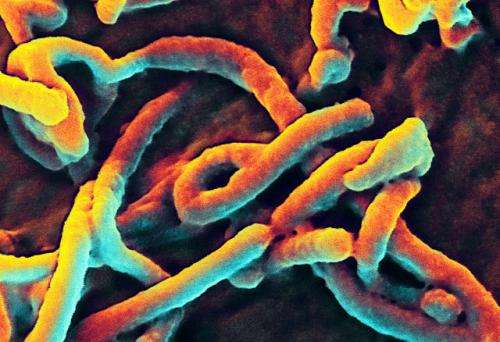Hollow tree was Ebola's Ground Zero, scientists say

Insect-eating bats that inhabited a hollow tree in a remote village in Guinea may have been the source of the world's biggest Ebola epidemic, scientists said on Tuesday.
More than 20,000 cases of Ebola, with at least 7,800 deaths, have been recorded by the World Health Organization (WHO) since a two-year-old boy died in the village of Meliandou in December 2013.
Reporting in the journal EMBO Molecular Medicine, scientists led by Fabian Leendertz at Berlin's Robert Koch Institute delved into the circumstances surrounding this first fatality.
The finger of suspicion points at insectivorous free-tailed bats—Mops condylurus in Latin—that lived in a hollow tree 50 metres (yards) from the boy's home, they said.
"The close proximity of a large colony of free-tailed bats... provided opportunity for infection. Children regularly caught and played with bats in this tree," the team said after an exhaustive four-week probe carried out in April.
The Ebola virus holes up in a natural haven, also called a reservoir, among wild animals which are not affected by it.
The virus can infect humans who come into contact with this source directly, or indirectly through contact with animals that have fallen sick from it.
Highly contagious, the virus is then passed among humans through contact with body fluids.
A known reservoir is the fruit bat (Epomophorus wahlbergi), a widespread tropical African species that in some countries is killed for food, offering a infection pathway to hunters and butchers of the mammal.
But the role of fruit bats in the current outbreak has never been confirmed, the scientists said.
In contrast, free-tailed bats, a cousin species, have been found in lab tests to be able to carry the virus but not fall sick with it.
That, too, would make them a "reservoir," but no evidence of this has ever been found in the wild.
The German team said evidence that this species helped unleash the present epidemic was strong but not 100 percent.
Local children not only played with the bats at the tree, they also hunted bats that roosted at village homes and grilled them for food, they found.
In addition, they saw no evidence of any local die-off among larger mammals, which would have been a secondary route of infection for humans.
On the other hand, no trace of Ebola virus was found in any of the bats the scientists captured and whose blood was analysed.
'Rare' virus
When the researchers came to Meliandou, they found the bat colony had fled, for most of the tree had burned and only the stump and branches remained.
Traces of DNA found in surrounding ash and soil pointed to the previous presence of the insect-eating bats. But again, there was no presence of Ebola virus.
"The virus must be very rare in the reservoir," Leendertz said in an email exchange with AFP.
"That is also obvious when you think about how many tonnes of bat meat is consumed every year.
"If more bats carried the virus, we would see outbreaks all the time. That's one of the challenges: the virus is rare and (in) a large multi-species reservoir."
The possibility that this species of bat could be an Ebola vector is a worry, said Leendertz.
Very little is known about how these bats live—when they migrate and reproduce, where and why they cluster, their sources of food, and so on—and only understanding this will quantify the risk for humans.
Africa's population explosion has destroyed more and more of the bats' habitat and brought more people into proximity with them.
Leendertz said an early priority should be to encourage co-existence between villagers and bats.
Culling the insect-eating animals could encourage the spread of insect-borne disease.
"It is no solution to start killing bats or disrupting their habitat. That may backfire very badly," he warned.
More information: EMBO Molecular Medicine, DOI: 10.15252/emmm.201404792
© 2014 AFP




















